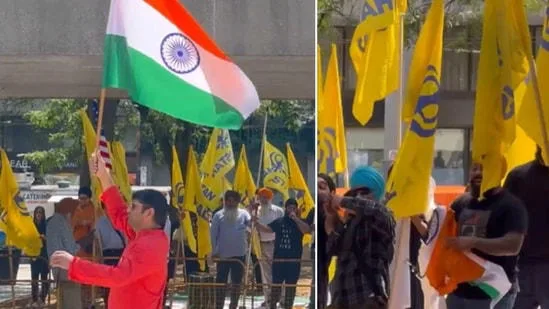The India Day Parade in Toronto, one of the largest celebrations of India’s independence outside the country, was marred by tensions as dozens of pro-Khalistan protesters disrupted the event. The parade, held at Nathan Phillips Square on August 18, was organised by the Indian diaspora and featured the “largest Indian flag outside India” along with several floats representing various Indian states.
Protest and Disruption
A viral video circulating on social media, which has not been independently verified by Organiser but has been widely reported by multiple media outlets, captured the heated confrontation between pro-India and anti-India groups.
The video, shared by Calgary-based journalist Mocha Bezirgan, shows members of the Indian diaspora countering the pro-Khalistan protesters with chants of “Bharat Mata Ki Jai” as the other side shouts “Go back to India.” Bezirgan also reported that some of the Khalistani supporters tore apart the Indian national flag with a knife, further escalating the tensions.
“GO BACK TO INDIA:” Khalistanis yelled at an India Day gathering at Toronto City Hall while ripping apart the Indian flag with knives.
Their protest to counter the event was billed as the “next face-off” after a confrontation in Surrey, BC, on India’s Independence Day.
Tensions… pic.twitter.com/jaNtXsVMlI
— Mocha Bezirgan 🇨🇦 (@BezirganMocha) August 18, 2024
This incident is part of a growing pattern of confrontations between Indian supporters and Khalistan separatists in Canada. Just a few days earlier, on India’s Independence Day, a similar clash occurred in an industrial area near Surrey, British Columbia, highlighting the rising tensions within the Indian community in Canada.
Heightened Security and Political Context
The Toronto parade took place under heightened security due to the anticipated counter rally by pro-Khalistan groups. Despite the security measures, the protesters managed to disrupt the celebrations, creating a charged atmosphere that threatened to overshadow the parade’s intended purpose of honouring India’s 77th Independence Day.
Bezirgan, in his posts on X (formerly Twitter), pointed out the apparent leniency afforded to Khalistan supporters in Canada. He noted that the group “Sikhs for Justice” and other Khalistani factions seem to enjoy a higher threshold of liberty when it comes to making inflammatory statements like “go back to India” and “kill India.”
Ram Mandir float in New York
The streets of New York burst into a vibrant display of colours and sounds as the 42nd Annual India Day Parade made its way down Madison Avenue, drawing several hundred participants and spectators. The event was a powerful celebration of the Indian diaspora’s deep connection to their cultural roots, reflecting the richness of India’s heritage in the heart of the city.
A highlight of the parade was an intricately crafted wooden float, standing 18 feet long, nine feet wide, and eight feet high, that depicted the grand Ram temple of Ayodhya, made of pink sandstone. This magnificent float, carved in India, was specially shipped by air to the U.S. to be part of the parade, symbolising the pride and devotion of the Indian community abroad.
#WATCH | Visuals of India Day Parade from New York; a carnival float featuring Ayodhya’s Ram Mandir is also part of the parade pic.twitter.com/9DgbbZBi2X
— ANI (@ANI) August 19, 2024
The event featured more than 40 floats, 50 marching groups, and 30 marching bands, as per the Federation of Indian Associations. One of the central attractions was an 18-foot-long wooden float depicting the Ram Mandir in Ayodhya, which had been shipped from India. The float also featured an idol of Ram Lalla, unveiled by Prime Minister Narendra Modi earlier this year during the Pran Pratishtha ceremony on January 22.
The inclusion of the Ram Mandir float had sparked controversy even before the parade. Some U.S.-based organisations, including the Council on American-Islamic Relations (CAIR), the Indian American Muslim Council (IAMC), and Hindus for Human Rights, sent letters to New York City Mayor Eric Adams and New York Governor Kathy Hochul, expressing concerns that the float glorified the demolition of the Babri Masjid and was “anti-Muslim.”
Broader Implications and Ongoing Concerns
The disruptions in Toronto reflect a broader trend of rising tensions between pro-India and pro-Khalistan factions in Canada, a country that has seen an increasing number of such confrontations in recent years. The growing influence of Khalistan supporters, particularly in areas with large Sikh populations, has raised concerns within the Indian community, as well as among Canadian authorities.
As these incidents continue to unfold, the Indian diaspora in Canada finds itself caught between celebrating its heritage and navigating the complexities of political and religious identities that often spill over into public events.




















Comments